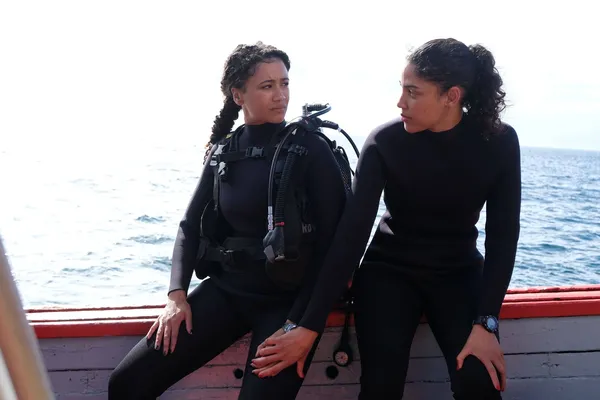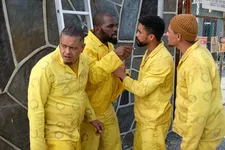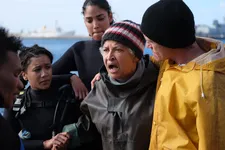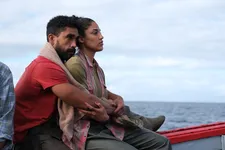 |
| Bronté Snell and Shamilla Miller in The Umbrella Men: Escape From Robben Island |
At last year's Toronto International Film Festival, one of the highlights was lively South African musical comedy heist film The Umbrella Men, which featured a gang of amateurs led by reluctant musician Jerome (Jacques De Silva) who come up with an elaborate scheme to steal money from a corrupt bank and thereby save their beloved club. Equally lively were the interviews with director John Barkers and stars Jaques De Silva, Shamilla Miller, Keenan Arrison and Bronté Snell which followed, given that they had never expected to find themselves on the world stage. This year they're back in Toronto with a sequel, The Umbrella Men: Escape From Robben Island - which, as you can imagine, means that the seemingly perfect getaway in the first film turned out to have complications.
This time around, the female characters have moved to the fore, and the behind the scenes stories are as thrilling as the film itself. Shamilla and Bronté rejoined me, along with John, who summed up their excitement at getting to do it all again.
“It's been fantastic,” he says. “With sequels there’s always a lot of pressure. Everyone says ‘Don't do a sequel. You’ll make that same mistake of trying to recreate the first one.’ So we kind of changed up the genre. We didn't want to do another heist so we did a prison break with a strong emphasis on the girls being the lead and blasting the guys out of prison. So to be back in Toronto, Jennie, is just fantastic. It's such a joy.
“In the first one, there was a big emphasis on the guys, and Shamilla said ‘John, you’ve got to learn to write for girls!’ So in the second one, I really wanted to spend more time with the girls and we knew the audience. It was a bit tricky, because in the first one we introduced, the guys, and particularly Jacques - his character Jerome – as the lead. So we had to, in some way, feature the girls. But I think even in the initial drafts, there were possibly more scenes with the girls.
“I hope there is a sense of the girls featuring more in this film. If we decide we move into another one, we might do even more with the ladies, because they're such fantastic actors. The characters are so strong. They're just amazing on screen.
 |
| The men are in serious trouble this time |
“We were trying to find something very iconic in Cape Town. Because everyone knows Robben Island from the ANC and the history of the island, we thought ‘Why don't we fictitiously reopen the island and send our guys there?’ Then the girls have to rescue them. Because for the girls, this is not their first choice, to be these gangsters. It's because the guys keep getting into shit and they have to bail them out. So it's a big challenge for their characters to now have to scuba dive or to get out of their comfort zones – for Mila to stop playing music, to go and help the family, and for the Keisha to go from the banking world into this Jack Sparrow on the high seas.”
“The thing that I love about the second movie is that we all thrown in the deep end,” says Bronté . “The guys get in trouble and the girls have to come to the rescue and play the heroes and get them out of prison. Get into all this gearn and do hero stuff. It's actually very realistic because Keisha and Mila don't know these things. That's why we go to our experts, we go find out how can we get the guys out of prison. We're just going to do it, we have to get them out. And then for Mila having to leave behind - well, we don't know yet if she leaves it behind, but she has to put it on pause.
“This is her family so I think it was a no-brainer to just leave everything and go save the boys. This is what family is all about. And that's what I love about this movie – that there's a strong family theme. We risk it all for the family just because we love each other, and I think that's beautiful, and it comes through quite strong.”
I ask Shamilla how much she thought about what had happened to her character between the two films.
“In the first film, she is working in the banking industry and trying to trying to advance her life within the economical sector in that way,” she says. “And by the time we get to the second film, she's no longer working at the bank. She's coupled up with Jerome, she's basically just engulfed herself into this new life, this new family that she absolutely adores, because I think that was something that was missing in Keisha’s life before, the strong sense of family – and that's what these characters have given her. So this new life that she has thrown herself into has become the centre of her life.
“She's no longer working at the bank, she no longer has those things going on, but she's still a very ambitious character. She still has goals and dreams for herself. And whatever she puts herself into, she's going to do 100%. So when this situation unfolds, and they have to do a little prison break, or go into this whole underworld of criminality, well, like Bronté said, it's something that we do for family. So without even skipping a beat, she's like, ‘Okay.’ And she's an ambitious planner, so I feel like she easily slips into this role of of hero and go-getter, because of where she's come from before.
“It was so much fun. Being able to play this type of role and being able to continue the role in a sequel that's got so much more action for me as a performer to play around with has been so satisfying and so great. To advance and play something bigger and play more of a structural role within a film when it comes to the planning and control, it's so much fun. And then physically having to do the action, you know, we did a lot of our own stunts and we were in the water and we were driving around. It was just it was so much fun to do all of those action things.”
I ask about the scuba diving and both women stress that there were no special measures taken to make it easy on them.
“We were in cold water,” says Shamilla. “I mean, we've got two different oceans, the Atlantic and the Indian. They’re both cold. But we were a little bit more on the on the warmer side. So I think we were in like 13°c water instead of like 10°c or 11°c water. And the weather gods played nice with us. The weather was really pleasant while we were filming. And then honestly, Bronté and I are such adventurous women already, and go-getters, so we honestly just had a lot of fun on set. We were in and out of the water, we did our scuba certification. And there was one day – Bronté, how many hours were we in scuba gear on the ocean floor, trying to get different shots?”
“There was one day set aside for shooting underwater,” Bronté recalls.
 |
| The women get help from the community |
“We had a good time,” Shamilla continues. “We're just so thankful that we were able to do it, and that like roles like this exist.”
“It's definitely a dream come true in my career to shoot that,” says Bronté. “I mean, it's one thing to do it in your life, but then to be able to shoot it in your career, it's pretty cool. This was our first time doing that, as well as for John and the DoP [Motheo Moeng]. So you have to trust each other. We had to figure out, ‘Okay, how can we communicate better? How can we shoot this and not put each other in danger, but also get the shots? But I think we did a really good job, it having been our first time. It was pretty epic.
“In the first film, we didn't get to shoot much together but obviously, we grew close, because we were seeing each other all the time. But now, the second time around, getting to shoot with one another was really cool because we could allow our chemistry as friends to develop and enhance that, growing something and going into banter and just how chicks are, you know? I love that for our characters. And yeah, we get to see the characters grow, when the women are at the forefront.
“Keisha is a planner, she's a leader, she can delegate. Mila is a go-getter, she’s a good swimmer, and she's also very physical. She can knock some guy out. Wee get to see these things. And I think it's also realistic, because that's how women are. We need to do something, we get it done, especially here in the Cape, especially our Cape Malay woman. If there's something that needs to get done, we'll do it.”
Although the women are very determined, they can’t do it alone. They need gear and training, which means that they need money, so, as in the first film, they need to put together a plan and find people in the underworld who can help them to bring it to fruition.
“We want to keep the Tendeka character [played by Kagiso Lediga] still in the film,” explains John. “One way of doing that was to keep him as the loan sharks, even though there was the element of him possibly double crossing them. It was really the only option, to go to get money from him. So they get a certain amount of money to do the job, but then again, it's not enough to go and get the best people in the world, so they have to go to the community.
“They go to somebody who's not necessarily an expert scuba diver, but somebody who's taught some of the local fishermen how to dive for abalone, etc. And so they use their skills and they use the community and the people in the community have got certain skills, and then asked them to step up a level. Those people they’re going to aren’t criminals, but they have an element of the skills that the girls need to get the guys off the island.
“It was really cold, and the girls were absolutely amazing. I mean, we spent, like Bronté said, a whole day training in the open sea. And on the two days of shooting, we spent all day in the sea, surrounded by sharks, surrounded by whales, surrounded by all kinds of weird stuff. So they were absolutely incredible. We wrote it hoping that they would be up for the challenge, and they were more than up to it.”
Were they nervous, filming around sharks?
“We were, yes,” he says.
Shamilla squints at him. “Were you nervous? I don't know why, I was nervous when I read the script, but then when we were in the ocean, there were so many other things to factor in that sharks were the last thing on my mind. I was just trying to survive. So I didn’t think of sharks, honestly.”
“No one was scared,” John clarifies. “But at some stage, I realised we are in the sea. We're not in some tank or far away in some bay. There are are sharks and there are whales in the perimeter that we’re in. I wasn't scared but I was like, here we are, directors, producers, in this world at this moment – can you imagine something had happened?”
“We were shooting in Simon's Town, which has got a huge great white population, the highest in our area,” Shamilla adds.
 |
| Relaxing with her man: Keisha and Jerome |
“It was crazy,” Bronté reflects.
“When I write these things, I get very, very ambitious. And I don't think about budgets,” John admits. “I had this whole thing with Keisha and with Mila, and – talking about how ridiculous this is for writing – this idea that the third time they went into the water, they would take the shark cage into the water, and then they would take instruments, they would cut. There was a cage set up in the cave area, fictitiously, on the island, but they needed to practice. So to create a sense of danger for the girls, Keisha was cutting this shark cage and Mila was watching to see that everything was cool. And then, because they're quite far away, Mila then turns and she sees this shark circling around. So she's trying to warn Keisha that there's a shark coming, and then the shark heads towards Keisha, and it opens its mouth, and then she ducks out of the way and they swim. I mean, really, my goodness. I think I said that to Joel [Phiri, one of the producers] and he said ‘John, just stop.”
He has become quite animated whilst explaining this, waving his arms around, and the women are in fits of laughter. To calm the situation down a bit, I talk about some of the other violence that we don’t see in the film. Notably, there are hardly any guns fired, which is very different from the average thriller these days.
“Yeah, I think even in Umbrella Men 1 we only had one incident where somebody was shot, he observes. “And again, in this one, we didn't want to push it. While we were borrowing from tropes of prison break films and hesist films, it was more about our characters in this case. That's what probably has driven us to make the second one because the characters are so strong. We rely more on their performances and it feels like it's character driven. So we're aware that with this genre of film, violence is definitely part of that, but in no way that we feel like we need to push the violence too much to make the characters believable in their pursuit of getting the guys off the island.”
I point out that when we do see violence, including the fights which take place in the prison, they provide an opportunity to talk about character,
“Yes, definitely. We always keep a sense of humour about things as well, like the moment when the girls get to the island and then Keisha tells Mila that she has to go knock the guy over the head, because she just had her nails done, because she's going to see Jerome. Because it's a comedy, we always like to balance the action and violence with the character. So when Jerome is fighting in the corridor in the prison, it's Mortimer [Keenan Arrison] who's helping him do that, and he's warned by Goobie [Sivuyile Ngesi], what to do, and then they’re all hiding it together. So there's always a sense of community, that they're looking after each other, even though it's a violent scene. It's always as strong as a comedy. It's a very funny part of the film. We're not doing heavy drama, we're not doing a heavy gangster film. It's always gangster with a sense of humour.”
Coming up: John Barker, Bronté Snell and Shamilla Miller on music, iconic Cape Town locations and going back to the Bo-Kaap





















